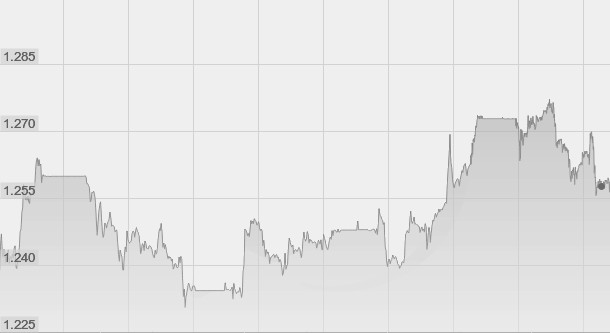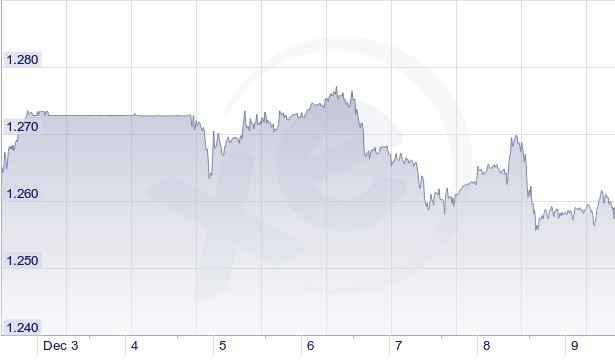The recent strengthening of the British Pound has seen the currency rise from November lows of $1.23 to a December peak of $1.27. Bearish sentiment is however on the rise, and the conditions which have seen the Pound trading at 30-year lows have not so much receded, as quietly slipped out the door while no one was watching.
It is true that there has increasing speculation about a Soft-Brexit, and trade figures have been a little better than expected, however with levels of upward resistance strong, and Sterling unlikely even in the best of circumstances to break above a valuation in the $1.27 range, downward pressure is likely to mount.
Outright predictions of doom have proven false, as they usually do, but the British economy has opted to chart a course through choppy waters, and the real storms are still some months away. In the medium term the Pound seems likely to face renewed downward pressure, and a return to more recent levels below $1.25 is a distinct possibility.

Whilst it may be the case that bearish sentiments on Sterling will ring true in the short term, there are presently plenty of upsides to the British currency. These should not entirely be discounted. Economic data since Brexit has, for the most part, been better than expected. Even the recent unexpected construction dip of .2% needs to be taken in the context of a yearly rise. Whilst not the world's largest oil exporter, the recent cuts agreed by OPEC are still good news for British assets in the North Sea. The weekend's meeting between OPEC and other major oil producers might also bring further good news, with the Russian government for one pledging to support the OPEC cuts with its own reduction of 300,000 barrels a day. Continued sluggishness in the Eurozone, a sentence that seems to have lost all meaning owing to over-use, of course adds to the current positive sentiment around Sterling, as do more doveish statements on Brexit. Access to the single-market may not be as unlikely as was once feared, and David Davis, Brexit Secretary, is seemingly content to pay for the privilege. Unemployment is low, consumer spending remains strong, and wages are finally rising. For the British economy there seems to be plenty of reason for some festive cheer, however short-lived it may prove.

Interestingly, whilst uncertainty is normally bad for market sentiment, uncertainty over Brexit has in some ways also become good news for the British currency. No one knows precisely what form Brexit will take, and there is a direct correlation between news which supports soft-Brexit and a strengthening of the Pound. The current uncertainty over whether the British government has the right to trigger Article 50 without parliamentary support keeps analysts guessing. As a result of this the real costs of Brexit have yet to be fully priced into the valuation of the Pound. Should, as is likely, the British Supreme Court rule that Parliamentary approval is needed, climbs in the GBPUSD exchange of up to 1.5% could be in the offing.
-636168955432322414.jpg)
The fact is however that although bullish sentiment is not baseless, it does appear short-termist. Indeed, in the next few days, the long awaited U.S. rate hike, expected on the 14th of December, is likely weaken Sterling's recent uptick against the Greenback, as the British currency's failure to break higher levels of upside resistance at around $1.27.
Trading attention is now beginning to swing back around to testing Sterling's support levels. This threatens a near-term slide in the Pounds value. Only a sustained level above $1.27 is likely to reduce long-term bearishness, and having fallen back below the $1.26 mark, such a climb seems unlikely.
Whilst the negativity of early October has given way, it has not entirely abated, and Forex investors will be quicker to jump-ship given the Pound's 2016 volatility. This means that levels of support are far less secure than they once may have been. Every negative news story has the potential to trigger the market into aggressively testing the British currency, and whilst the opposite is also true, upward resistance is likely to prove much stronger than its negative counterpart. Furthermore, it is unlikely that the Pound will turn any long-term corner until after Brexit uncertainty abates. Recent rises may be little more than a case of traders testing the waters, and already a decline seems to be setting in, with the GBPUSD exchange rate falling in the last three-days of trading, from highs of $1.27 to lows of $1.25.


In addition to short term potential for a decline in Sterling, the long-term conditions mentioned at the start of this article remain. As everyone is no doubt tired of hearing, Brexit means Brexit, and even a soft Brexit is bad news for markets. The Pound is in a weaker position today than it was at the start of the year, and it should not be forgotten that there is a reason the Pound has fallen by nearly a third since its 2014 high of $1.71. Whilst the Pound has climbed recently, it would not be unfair to label its mini-revival little more than a relief rally.

In the near term then, the Pound seems likely to keep trading around the $1.25 mark, with some dips below being very possible. This being the case, analysts from UOB Group suggesting a trading range of 1.2480/1.2750. After the U.S. rate decision, the Pound may dip further with Levels of support almost certain to be tested. In the medium-term however, another rally is likely, especially if the Supreme Court supports the High Court's Brexit decision. Should the court decide that the separate claims made by the Northern Irish and Scottish governments for an effective veto on Article 50 gain support, then that rally would really gain legs.
A longer-term rally is however the least likely outcome, and Tim Riddell of Westpac's bearish view that the recent GBPUSD rate is little more than a hiatus may be far closer to the mark. Riddell suggests that 'uncomfortable Brexit realities should send GBP/USD back to the low 1.20s'.
Ultimately, whilst there is some short-term cause for optimism, the long-term GBPUSD exchange rate is likely to find stable levels of support somewhat lower than recent highs might suggest.
Risk warning: Spreadbetting, CFD trading and Forex are leveraged. This means they can result in losses exceeding your original deposit. Ensure you understand the risks, seek independent financial advice if necessary. The value of shares and the income from them may go down as well as up. Nothing on this website constitutes a solicitation or recommendation to enter into any security or investment.
Recommended Content
Editors’ Picks
EUR/USD clings to daily gains above 1.0650

EUR/USD gained traction and turned positive on the day above 1.0650. The improvement seen in risk mood following the earlier flight to safety weighs on the US Dollar ahead of the weekend and helps the pair push higher.
GBP/USD recovers toward 1.2450 after UK Retail Sales data

GBP/USD reversed its direction and advanced to the 1.2450 area after touching a fresh multi-month low below 1.2400 in the Asian session. The positive shift seen in risk mood on easing fears over a deepening Iran-Israel conflict supports the pair.
Gold holds steady at around $2,380 following earlier spike

Gold stabilized near $2,380 after spiking above $2,400 with the immediate reaction to reports of Israel striking Iran. Meanwhile, the pullback seen in the US Treasury bond yields helps XAU/USD hold its ground.
Bitcoin Weekly Forecast: BTC post-halving rally could be partially priced in Premium

Bitcoin price shows no signs of directional bias while it holds above $60,000. The fourth BTC halving is partially priced in, according to Deutsche Bank’s research.
Week ahead – US GDP and BoJ decision on top of next week’s agenda

US GDP, core PCE and PMIs the next tests for the Dollar. Investors await BoJ for guidance about next rate hike. EU and UK PMIs, as well as Australian CPIs also on tap.